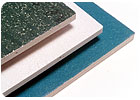DensDeck Prime Assemblies Exceed New FM Requirements
ATLANTA - Georgia-Pacific Gypsum announced that recent FM Approvals tests give three different roof assemblies using DensDeck® Prime 225, 285 and 315 PSF listings, respectively.
 ATLANTA - Georgia-Pacific Gypsum announced that recent FM Approvals tests give three different roof assemblies using DensDeck® Prime 225, 285 and 315 PSF listings, respectively. According to Reinhard Schneider, Technical Development Manager, DensDeck Roof Board Products, roof assemblies using DensDeck Prime in fully adhered membrane assemblies over steel decks met or surpassed the new FM requirements for perimeters and corners not only for the 90 PSF rating commonly used in coastal areas, but also a more severe 120 PSF rating.
ATLANTA - Georgia-Pacific Gypsum announced that recent FM Approvals tests give three different roof assemblies using DensDeck® Prime 225, 285 and 315 PSF listings, respectively. According to Reinhard Schneider, Technical Development Manager, DensDeck Roof Board Products, roof assemblies using DensDeck Prime in fully adhered membrane assemblies over steel decks met or surpassed the new FM requirements for perimeters and corners not only for the 90 PSF rating commonly used in coastal areas, but also a more severe 120 PSF rating.
The following assemblies were built and tested at FM Approvals:
Assembly No. 1 - Achieved FM 225 PSF
• 3-ply glass felt Type III, asphalt mopped
• 1/2-inch DensDeck Prime, attached to the deck
• 24 No. 14 fasteners and 3-inch plates per 4-foot by 8-foot board.
• 1.5-inch polyisocyanurate insulation, loose laid
• Grade min. 33 KSI steel deck, attached to purlins per FM requirements
Assembly No. 2 - Achieved FM 315 PSF
• 3-ply glass felt Type III, asphalt mopped
• 1/2-inch DensDeck Prime, attached to the deck
• 32 No. 14 fasteners and 3-inch plates per 4-foot by 8-foot board
• 1.5-inch polyisocyanurate insulation, loose laid
• Grade min. 33 KSI steel deck, attached to purlins per FM requirements
Assembly No. 3 - Achieved FM 285 PSF
• 45 mil fleece-backed EPDM membrane fully adhered
• 1⁄2-inch DensDeck Prime attached to the deck
• 32 No. 15 fasteners and 3-inch plates per 4-foot by 8-foot board
• 1.5-inch polyisocyanurate insulation, loose laid
• Grade min. 33 KSI steel deck, attached to purlins per FM requirements
In addition, Schneider stated that a number of membrane manufacturers have tested various types of DensDeck roof board with their adhered membranes and have achieved a variety of high uplift results, and other tests are ongoing. He also noted that wind uplift requirements are determined by a number of factors including but not limited to geographical region, local geography, importance and exposure factors, as well as building design, and cautioned that decisions about roofing system designs should not be based solely on this brief summary.
For more information, call Georgia-Pacific Gypsum’s Technical Hotline at 800-225-6119 or visit www.densdeck.com.

Georgia-Pacific Gypsum recently tested three different roof assemblies using DensDeck Prime, and they achieved 225, 285 and 315 PSF listings, respectively.
The following assemblies were built and tested at FM Approvals:
Assembly No. 1 - Achieved FM 225 PSF
• 3-ply glass felt Type III, asphalt mopped
• 1/2-inch DensDeck Prime, attached to the deck
• 24 No. 14 fasteners and 3-inch plates per 4-foot by 8-foot board.
• 1.5-inch polyisocyanurate insulation, loose laid
• Grade min. 33 KSI steel deck, attached to purlins per FM requirements
Assembly No. 2 - Achieved FM 315 PSF
• 3-ply glass felt Type III, asphalt mopped
• 1/2-inch DensDeck Prime, attached to the deck
• 32 No. 14 fasteners and 3-inch plates per 4-foot by 8-foot board
• 1.5-inch polyisocyanurate insulation, loose laid
• Grade min. 33 KSI steel deck, attached to purlins per FM requirements
Assembly No. 3 - Achieved FM 285 PSF
• 45 mil fleece-backed EPDM membrane fully adhered
• 1⁄2-inch DensDeck Prime attached to the deck
• 32 No. 15 fasteners and 3-inch plates per 4-foot by 8-foot board
• 1.5-inch polyisocyanurate insulation, loose laid
• Grade min. 33 KSI steel deck, attached to purlins per FM requirements
In addition, Schneider stated that a number of membrane manufacturers have tested various types of DensDeck roof board with their adhered membranes and have achieved a variety of high uplift results, and other tests are ongoing. He also noted that wind uplift requirements are determined by a number of factors including but not limited to geographical region, local geography, importance and exposure factors, as well as building design, and cautioned that decisions about roofing system designs should not be based solely on this brief summary.
For more information, call Georgia-Pacific Gypsum’s Technical Hotline at 800-225-6119 or visit www.densdeck.com.
Looking for a reprint of this article?
From high-res PDFs to custom plaques, order your copy today!




